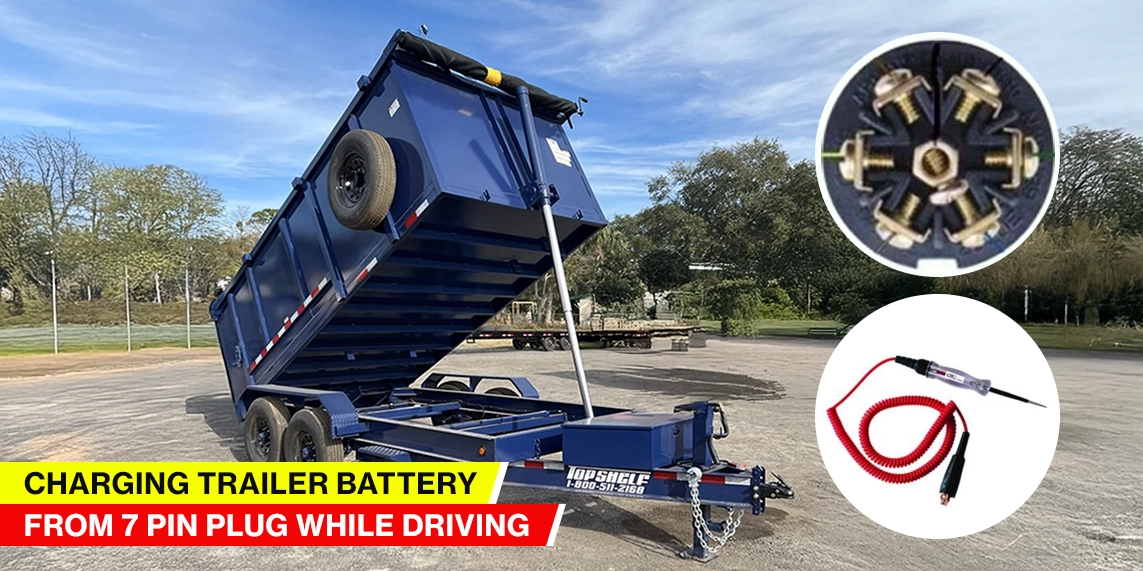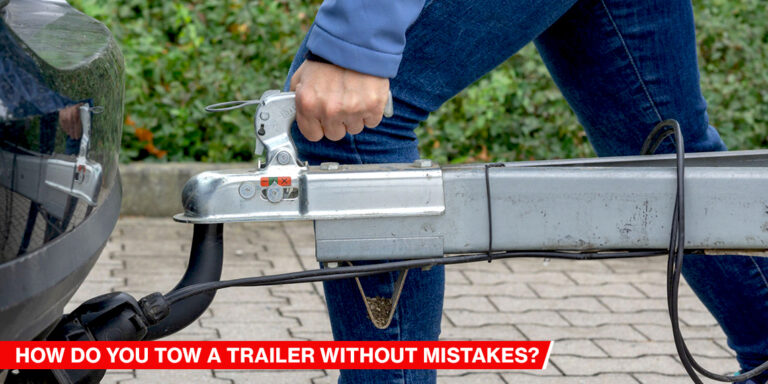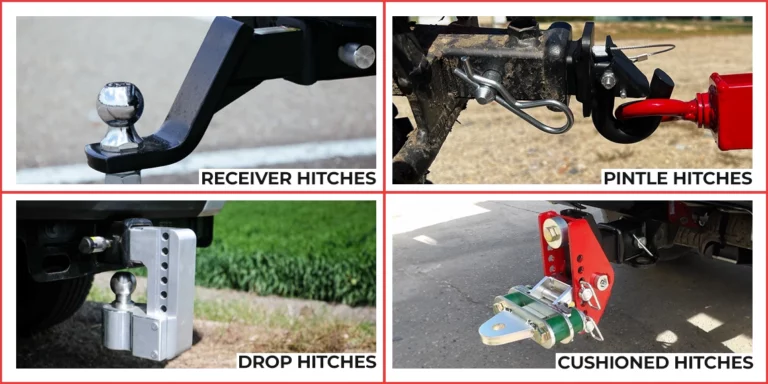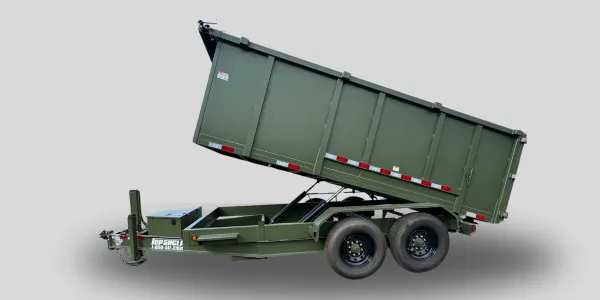Upon landing at a job site, you are not the first to experience trailer battery drainage. A dead battery can damper your plans, whether you want to use the trailer for heavy-duty work or a weekend getaway.
But we have some good news for you. There’s an effective, built-in solution that many are yet to discover. You must consider charging the trailer battery from a 7-pin plug while you drive.
You can charge your trailer while you are on the road. This means you don’t need generators, solar panels, or shore power. But you must ensure the right setup for it to work.
This blog will help you navigate everything relevant to the topic. You will learn how the 7-pin connection delivers power, the necessary components, and how to set up an efficient system.
A detailed breakdown will help you realize the potential of a 7-pin trailer plug charge battery on the go.
Understanding the 7 Pin Trailer Plug and Charging Capabilities
The 7-pin trailer plug can best be defined as a direct connection between trailers and towing vehicles. The seven pins have respective roles in the process: turn signals, reverse lights, and brake lights. Also, there’s the auxiliary power—it fuels the 12v battery charging through the 7-pin.
Not all tow vehicles feature the auxiliary pin for powering the battery. However, if they do, you can use them to juice up your trailer battery while driving. The element of convenience present in this scenario can benefit your trailer battery during trips. You no longer need to think of manual recharging as a reactive approach.
How The Charging System Works?
The alternator starts producing electricity when you pair the trailer with the 7-pin plug. Part of this electricity will run through the auxiliary power wire 7-pin to the trailer.
Although it powers the battery while the trailer is running on the road, it only provides a consolidated charge rate compared to direct charging methods. To activate proper wiring and safe operation, you will need fuses and potentially a DC-DC charger.
Essential Components of Trailer Battery Charging System
You must ideally guarantee the perfect components for your system. This is necessary before fueling your battery using the 7-pin plug while driving the trailer. The collective combination of compatible equipment, proper wiring, and innovative safety features impacts the charging capability.
We have detailed each essential part of the setup for your benefit:
| Component | Purpose |
| 7-Pin Trailer Plug | Provides power and lighting connections between vehicle and trailer |
| Auxiliary Power Wire | Carries 12V current to trailer battery |
| 10-Gauge Wire | Reduces voltage drop and supports higher current |
| DC-DC Charger | Regulates voltage; ideal for smart alternator systems |
| Fuse | Prevents overcurrent and protects wiring |
| Battery Isolation Switch | Prevents back-drain from trailer battery when vehicle is off |
1. A Compatible 7 Pin Trailer Plug and Wiring
The 7-pin trailer plug wiring is often considered the foundation of any trailer battery charging setup. The regulated plug can be employed across most tow vehicles and trailers. It connects the turn signals, tail lights, and brake lights and also connects to a dedicated 12V auxiliary power line.
You must get a 7-pin connector for your tow vehicle and trailer to ensure proper wiring. This is necessary when charging a trailer battery. Crucially, the auxiliary pin must deliver 12 volts from the tow vehicle’s battery or alternator.
If your trailer’s 7-pin socket lacks this 12v trailer battery charger, we recommend running a new power wire from the battery using a fuse.
2. The Auxiliary Power Wire
The auxiliary wire serves as a gateway to deliver charging current from the towing vehicle to the trailer battery. To ensure perfect charging, you need a heavier gauge wire, at least 10-gauge wire, to cut down resistance and fend off extra voltage drop.
Underwhelming or poor-quality wiring can hinder the flow of current. This may compromise the amount of power that hits your trailer battery. You must get premium wiring to help your battery enjoy a usable charge even while on the move.
3. Potential Need for a Battery Charger for a Trailer
A direct 12V connection using a 7-pin plug promises a basic charge. However, advanced towing vehicles feature smart alternators that decrease output as soon as the battery is full. This leads to unsustainable charging and inconsistent voltage for the trailer battery.
To address it, you should set a DC-DC charger between the power line and the vehicle battery. We recommend it to provide the trailer battery with a standardized and consistent charge. It can happen regardless of how the alternator in the trailer behaves.
Furthermore, it prevents backfeeding and potential electrical damage, making it a must-have. Get your wallet if you want dependable battery performance while hitting the road.
4. Trailer Battery Isolation Switch
When you park your trailer, your trailer battery can always consume power from the battery of the towing vehicle. This could leave you stranded with a failing battery. To address this possibility, we recommend investing in an automatic battery disconnect relay or trailer battery isolation switch.
In simple terms, both these devices serve as a gatekeeper. They allow the power to flow only when the towing vehicle is running. Although some systems kick off with ignition power, you need a toggle switch to operate others manually. You can bank on both approaches to secure your vehicle’s battery and extend the lifespan of both electrical systems.
5. Battery for Trailer Brakes
Trailers featuring electric brakes should also get a breakaway battery system. This safety feature is required by law in many regions. It pushes the trailer brakes to engage and stop the trailer automatically if it detaches while driving.
The same 7-pin connector that powers your primary battery also charges the breakaway battery. However, you must ensure proper wiring and desired functioning. Sidestepping this system could compromise safety and lead to legal penalties.
Before investing in any dump trailer charging system, you must get detailed ideas of these essential components. It will assist you in charging your trailer battery using the 7-pin plug while driving. You can bank on this setup to keep your trailer road-ready.
Step-By-Step Guide: How to Charge a Trailer Battery from a 7 Pin Plug
The process of charging trailer battery from 7-pin plug while driving includes several vital steps. They contribute to guaranteeing safety, efficiency, and long-term reliability.
We have detailed the steps to help you set up and suitably manage the trailer charger.
1. Preparation and Safety Checks
i. Verify Tow Vehicle Compatibility for Charging
Before starting the charge, you must make sure that the 7-pin trailer connector in your towing vehicle can power the battery. Not all cars have similar wiring, so some may not have the 12V auxiliary power connection.
You must hit the vehicle’s ignition and use a multimeter to assess the corresponding pin. If the wiring is perfect, the metrics should show 12 volts or thereabouts. If not, you will need additional components or wiring modifications.
ii. Inspect the 7 Pin Connector And Wiring
To ensure robust battery charging, you will need a dependable electrical connection. Evaluate the 7-pin connector in both the trailer and the towing vehicle for possible signs of corrosion. Wipe the connectors using electrical contact cleaner. Also, ensure the wiring has adequate protection and insulation to prevent short circuits.
iii. Assess Your Trailer Battery
The battery in your trailer must be in perfect health to receive and keep a charge. Therefore, you must assess the battery for signs of swelling, damage, or leakage. Employ a battery tester or voltmeter to evaluate the voltage. Also, focus on cleaning the terminals and making sure the battery connections are corrosion-free and tight.
iv. Confirm Fuse/Circuit Breaker Protection
An automatic circuit breaker or inline fuse must ideally secure the 12V charging circuit near the battery or power distribution of the towing vehicle. You can bet on this protection to avoid fires or damage in case of a short. We recommend confirming the overall status of the breaker or fuse is intact.
2. Connecting the Trailer and Initiating Charging
i. Securely Connect the 7 Pin Trailer Plug
Once the assessment is complete, you must connect the 7-pin trailer plug from the trailer to the socket of the towing vehicle. You must seat and lock the plug in place perfectly to prevent power flow disruption due to vibrations while driving.
You must monitor some plugs that feature a weatherproof gasket or cap. Ensure they are in suitable condition to protect against moisture and debris.
ii. Start the Tow Vehicle
Activate the engine of your towing vehicle. Once the alternator starts producing power, electricity carries through the auxiliary wire in the 7-pin connector to the trailer battery. If all systems promise a perfect connection and functioning, the battery in your trailer will start accepting a charge. We recommend using a voltmeter at the trailer battery to check for a boost in voltage and confirm that charging is in progress.
3. Monitoring and Considerations During Charging
i. Understand the Charging Rate
Although the setup is convenient, you must manage your expectations according to pragmatism. Charging trailer battery from 7-pin plug often offers limited current, which is adequate for keeping or recharging the battery.
However, it is not perfect for rapidly refilling a deeply discharged battery. We recommend investing in a DC-DC charger between the tow vehicle and the trailer if you want more efficient charging.
ii. Be Mindful Of Power Consumption
You could fall prey to the temptation of using battery-powered systems when driving the trailer. But going overboard here can beat the input from the 7-pin connection. Therefore, you must consider checking the power consumption on the road. This will ensure that the battery on the trailer continues to receive a charge rather than lose it.
iii. Consider a Trailer Battery Isolation Switch
You should invest in an automatic relay or a battery isolation switch. These can disconnect the trailer battery from the towing vehicle’s electrical system when the engine is off. This will prevent the trailer battery from backfeeding, avoiding any possibility of battery drainage during stops.
4. Post-Trip and Maintenance
i. Disconnecting the 7 Pin Plug
Once your journey concludes, you must detach the 7-pin connector. We recommend refraining from twisting or yanking the plug excessively, as this can damage the pins or wiring. Once disconnected, cover the plug to secure it from water, dust, and corrosion. You may also consider occasional cleaning with dielectric grease to preserve connector integrity.
ii. Periodic System Checks
Implementing routine maintenance is necessary to secure long-term performance and safety. You must develop a habit of regularly assessing the trailer battery voltage and charging status. This is more valuable if the trailer sits idle for extended periods.
Run checks on every fuse condition and electrical connection. Also, find out if your vehicle’s alternator and charging system are working as expected. Routine assessment will prevent most charging issues before they occur on the road.
Safety Considerations
Charging your trailer battery via a 7-pin plug while driving offers a convenient solution. However, you must ideally set up any electrical system with safety in mind. We have detailed several key safety measures that you should follow to avoid battery damage, electrical faults, or even fire hazards.
1. Use Fuses on the 12V Line
Every power channel between the trailer and your towing vehicle should always have adequate fusing. You must check the use of fuses, especially the 12V auxiliary line, which contributes to charging the battery.
You must install an automatic circuit breaker or fuse as close to the power source as possible, which often means at the vehicle’s battery or fuse box.
This fuse serves as the initial guard line of defense, securing both the trailer and towing vehicle from damage due to wiring failures, accidental short circuits, or overloads. You must avoid ignoring this step to avoid risking the entire system and your safety.
2. Install a Relay or Isolation Solenoid
We recommend investing in a solenoid, relay, or battery isolation switch to secure your trailer battery against the tow vehicle’s battery drainage when the engine is inactive. These devices can manually or automatically disconnect the trailer battery charging circuit when the ignition is off.
This ensures that your vehicle does not lose power while parked or overnight. You could also use systems like voltage-sensing relays (VSRs), which automatically activate only when the vehicle’s alternator is active. They promise hands-free protection against unwanted battery discharge.
3. Check Battery Ventilation in the Trailer
If your trailer employs lead-acid or AGM batteries, you must check for suitable ventilation. This will help prevent the accumulation of hydrogen gas. You must install the batteries in ventilated compartments. Additionally, you can fit vent tubes that direct gas safely outside the trailer.
Don’t underrate the airflow when enclosing or installing your battery. Even sealed batteries can vent under extreme conditions. Lithium batteries often rank safer in this context, but all battery types enjoy some level of ventilation to prevent heat buildup.
4. Avoid Overloading the Circuit
Although a 7-pin plug offers a steady 12V source, its capacity is limited. It puts up no more than 10–15 amps of current, based on the vehicle alternator output and wire size. You will most likely go beyond the system’s capacity if you employ several 12V appliances while charging the tow vehicle’s trailer battery.
It could lead to a decline in voltage, damaged fuses, or poor battery charging performance. You must ideally be realistic about your trailer’s power demands. Also, if your electrical demands are greater than the potential of the 7-pin system, you must consider including a solar panel setup or DC-DC charger.
You can expect a charged trailer battery from the vehicle by adhering to these safety considerations. Furthermore, they promise security and sustainability. You must pay some attention to safety during installation to prevent major headaches.
Top Shelf Trailers Can Power Up Your Adventures
Using the 7-pin plug to power up your trailer battery while driving is a cost-effective and practical option. It can help ensure battery health when traveling, and you can count on this method to improve your trailering experience.
We recommend investing in safety measures, proper wiring, and assessing your system’s limitations. You must not allow a failing trailer battery to keep you from hitting the open road! As we said, you must ensure the perfect setup and detailed knowledge of the charging trailer battery from the 7-pin plug.
If you are looking for a battle-hard trailer, you must talk to the good folks at Top Shelf Trailers! They have the necessary expertise and craftsmanship to consistently deliver a trailer. Their trailer fleet can serve all your diverse demands, whether you tow your weekend toy hauler, haul gear, or run a dump trailer for your business.
You must visit Top Shelf Trailers immediately to check out their entire lineup. It will help you realize why more adventurers and professionals choose Top Shelf today.




